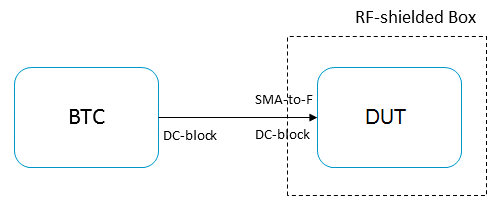Test Templates¶
Frequency Sweep Test Template¶
Imagine you want to measure the Power or SNR measurement accuracy of a satellite receiver compared to a vetted RF test instrument like the Rhode & Schwarz FSW. Perhaps your lab setup might look like this.

Block diagram of a power accuracy test setup. Both the FSW and DUT are tuned to a transponder generated by the SFU. Since the input signal is split into different paths, the individual path losses to the FSW and the DUT should be properly accounted for in the data analysis.
This automation script will perform a frequency sweep and measure MER/CNR and power at both the FSW and the DUT. An analysis of the measurement data can be found in SCTA_repo\src\examples\RF-Validation-Presentation.ipynb.
from SCTA.Instrumentation import SFU, VTR, FSW
from SCTA.System import Transponder
from SCTA.DataLogging import DataLogger
# Initialize equipment
sfu = SFU(type="IP", port="192.10.10.7")
fsw = FSW(type="IP", port="192.10.10.8")
dut = VTR(type="IP", port="192.10.10.9")
# Format output file
header=['Frequency (Hz)', 'VTR SNR (dB)', VTR Power (dBm)', 'FSW SNR (dB)', FSW Power (dBm)']
csv = Log(filename="FrequencySweep", format="csv", csv_header=header)
# Test DUT on a DVB-S2 MODCOD 13 transponder, i.e. 8PSK 2/3
txp = Transponder(id="101-txp1", mode=13, freq=974e6, symb=20e6, roll=20, scramb=0, pilots=False)
sfu.setTransponder(txp)
fsw.setTransponder(txp)
dut.setTransponder(txp)
# Test performance across L-band frequencies, i.e. 250 - 2150 MHz
for freq in range(250e6, 2150e6, 10e6):
sfu.setFrequency(freq)
dut.setFrequency(freq)
fsw.setFrequency(freq)
# Take measurements and write them to the output file
fsw_meas = fsw.getAllMeasurements()
vtr_meas = vtr.getAllMeasurements()
sample = [freq, vtr_meas['mer'], vtr_meas['power'], fsw_meas['mer'], fsw_meas['power']]
csv.push(sample)
BER Test Template¶
Imagine you want to test the frequency sensitivity of a satellite receiver to low power conditions near the specified QEF point. Perhaps your lab setup might look like this.

Block diagram of a frequency sensitivity test setup. The DUT is tuned to a low-power transponder generated by the BTC. The DUT does not lock to the signal at first, so the BTC power is increased until the DUT locks and measures no bit errors. This QEF point is measured across frequency.
This automation will perform a frequency sweep and find the QEF point for the DUT. An analysis of the measurement data can be found in SCTA_repo\src\examples\RF-Validation-Presentation.ipynb.
from SCTA.Instrumentation import BTC, VTR
from SCTA.System import Transponder
from SCTA.DataLogging import DataLogger
from time import sleep
# Initialize equipment
btc = BTC(type="IP", port="192.10.10.7")
dut = VTR(type="IP", port="192.10.10.9")
# Format output file
header = ['Frequency (Hz)', 'BTC Power (dBm)', 'Bert Lock', 'Bit Error Rate']
csv = Log(filename="FrequencySweep", format="csv", csv_header=header)
# Test DUT on a DVB-S2 MODCOD 13 transponder, i.e. 8PSK 2/3
txp = Transponder(id="101-txp1", mode=13, freq=974e6, symb=20e6, roll=20, scramb=0, pilots=False)
btc.setTransponder(txp)
dut.setTransponder(txp)
# Test performance across L-band frequencies, i.e. 250 - 2150 MHz
for freq in range(250e6, 2150e6, 10e6):
btc.setFrequency(freq)
dut.setFrequency(freq)
# Reset power level on the BTC
power = -85
btc.setPower(power)
# Run BERT for 5 seconds and check if the BERT is locked AND has no errors
dut.restartBERT()
sleep(5)
dut_meas = dut.getMeasurements()
# If not, then increase BTC input power by 0.1 dB
while (dut_meas['Bert Total Bit Error'] != 0) or (dut_meas['Bert Lock'] != True):
power = power + 0.1
btc.setPower(power)
dut.restartBERT()
sleep(5)
dut_meas = dut.getMeasurements()
# Else, stop the test and log the BERT statistics
sample = [freq, power, aim_meas['Bert Lock'], aim_meas['Bit Error Rate']]
csv.push(sample)